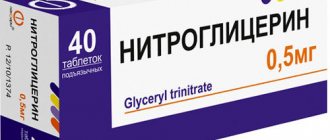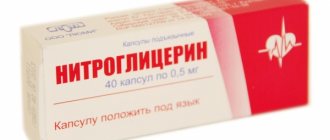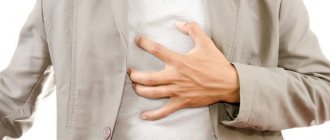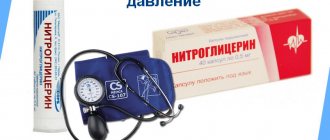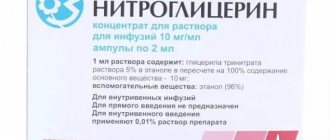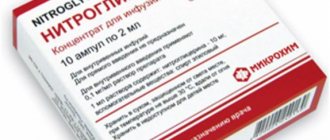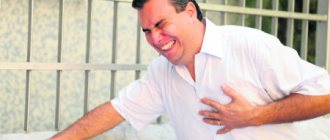Nitroglycerin has been the drug of choice for the treatment of angina pectoris for more than 100 years. Today it is used to relieve attacks in the form of sublingual tablets, sprays or aerosols. Nitroglycerin is also used for angina pectoris for prophylactic purposes in the form of prolonged-release tablets or transdermal therapeutic systems.
What is cardiac angina in simple words?
Angina pectoris is a clinical form of coronary heart disease (CHD), that is, its consequences. It occurs in almost half of patients with ischemia. Men suffer from it almost one and a half times more often. The colloquial name is “angina pectoris”. By the way, coronary heart disease is also it.
Pain that arises and subsides in the area of the heart in the form of an attack, which can radiate to the neck, jaw, teeth, left arm, forearm and shoulder blade - this is cardiac angina in simple words. The pain is compressive, burning in nature, occurs with a feeling of interruptions in the pulse rate, increased blood pressure and weakness.
No matter what viruses and infections plague us, no matter how alarming the statistics on coronavirus infections are, cardiovascular diseases are still the main cause of death for Russians. Unfortunately, in our country, about 17 million people suffer from various forms, and one of the most common problems affecting the heart and blood vessels is angina pectoris.
Treatment of angina pectoris: effective drugs and folk remedies
People say that angina is a disease that can last either 30 minutes or 30 years. Its insidiousness lies in the fact that attacks of the disease always occur suddenly and it is impossible to predict their occurrence. Therefore, when the first symptoms of angina occur, treatment should be started immediately.
Main symptoms and treatment of various forms of angina with medications
The signs and treatment of different forms of angina differ significantly from each other.
Common to all forms is not acute, but burning pain in the chest, sudden sweating, nausea and vomiting. Breathing slows down, pain radiates to the left side of the body.
With the clinical manifestation of so-called exertional angina, which manifests itself under various loads, characterized by nagging pain behind the sternum, radiating to the left arm or leg, nitroglycerin preparations successfully stop the attack.
Prevention and treatment of angina pectoris is aimed at relieving pain, preventing recurrent manifestations of the disease and taking measures to improve the prognosis of the medical history.
Symptoms and treatment of unstable angina, a heart disease in which myocardial ischemia acutely develops, depend on the clinical variants of its manifestation.
Experts distinguish several forms of this disease:
- Angina at rest, in which the symptoms of the disease last up to 20 minutes, occurring mainly at night.
- Rapidly progressive, which within a month goes through stages from stable to intense.
- For the first time (no more than two months ago).
With the first two types, the patient’s well-being tends to worsen, and in the latter case, the dynamics of the disease are unknown, which is why a final diagnosis is made only after two months, and then it is determined how to treat angina pectoris in accordance with the variability of its form - whether it is stable or not.
Nitrates, beta blockers, heparin and aspirin are prescribed to treat unstable angina. This form of the disease is an extremely dangerous stage of the acute phase of coronary heart disease, which has a negative prognosis.
Nitrates (for example, the so-called tablets for angina pectoris - nitroglycerin) in the treatment of this type of disease are designed not only to expand the lumen of blood vessels, which ensures the delivery of oxygen to the myocardium of the heart and reduces the pressure in its ventricles, but also to prevent thrombus formation. When prescribing nitrates, the cardiologist should warn the patient not to use them after taking diuretics, as this can lead to a drop in blood pressure and tachycardia, in which the heart rate increases to 100 beats per minute or more.
Drugs for angina (metoprolol, bisoprolol, anaprilin, blockarden, etc.) that block beta-adrenergic receptors should not be prescribed for existing symptoms such as bronchospasm, bradycardia, hypotension, congestive failure of the left ventricle of the heart. They are prescribed only for high systolic blood pressure in the vessels, ischemia and variant angina.
Heparin, a medicine for unstable angina, is also effective in cases of high risk. At the beginning of therapy, it is administered by bolus and then by infusion, which subsequently reduces the coagulation rate by one and a half times higher than the original one. You should avoid taking it if you have recently had a stroke and are at risk of bleeding. Heparin helps reduce the number of attacks and the duration of ischemia in a controlled period of time.
Aspirin, which is a platelet cyclooxygenase inhibitor, is often prescribed along with heparin. If there is a possible risk of bleeding or hypersensitivity to the drug, it should not be used.
For severe symptoms of angina at rest, treatment is expected to be comprehensive and include:
- Review of lifestyle (cessation of smoking, alcoholic libations, anti-cholesterol diet, bringing body weight back to normal).
- Drug therapy. To treat angina at rest, a complex of various drugs is used: antiplatelet drugs, beta-blockers, statins, inhibitors, nitrates and those that neutralize the effect of calcium ions.
- Surgical treatment, the purpose of which is myocardial revascularization. This type of treatment for angina pectoris involves methods of implanting a stent into the coronary arteries, as well as balloon angioplasty, which prevent their narrowing as a result of atherosclerotic changes. In addition, in particularly severe cases with a clear risk of death, a complex coronary artery bypass surgery is performed, in which the narrowing sites are duplicated with a parallel artificial vessel (shunt).
For exertional angina, treatment is aimed at quickly eliminating the factors that provoke the attack.
The pain symptom is relieved by taking sublingual nitroglycerin. With this type of angina, attacks can occur with a frequency ranging from several times a day to rare one-time manifestations with a frequency of several weeks or months. The medications and doses for the treatment of this type of angina are prescribed by the doctor, usually these can be long-acting nitrates, for example, dinitrate isosorbitol or a nitroglycerin patch; aspirin, which thins the blood and prevents blood clots; metaprolol or betaxolol from beta blockers; verapamil as a blocker of excessive calcium absorption.
If the prevention of angina symptoms is ineffective, radical treatment is used: coronary artery bypass surgery or stenting is performed. The treatment tactics for ischemic heart disease (angina pectoris) involve antianginal therapy, including the prescription of beta blockers in doses determined by the doctor taking into account heart rate, blood pressure, electrocardiogram readings, nitrates for stopping attacks and preventing them, statins and diuretics with the purpose of combating and preventing the development of heart failure.
In addition, metabolics can be prescribed as part of a complex of drugs for the treatment of angina pectoris and improvement of metabolic processes, among which actovegin, emoxypine, trimetazidine, etc. have proven themselves.
Concomitant treatment with folk remedies
A cardiologist should describe how to treat angina at home, compiling a list of medications, their dosage and frequency of administration. It is necessary to follow the doctor's instructions strictly and responsibly, because in order to ensure proper functioning of the heart muscles, correct and sufficient oxygen delivery to them is required.
Treatment of angina pectoris at home can also be combined with taking tinctures, herbal decoctions, and also following a certain diet aimed at strengthening the heart muscle.
Proper nutrition is aimed at avoiding foods with “bad” cholesterol, for example, any fried, smoked meat and sausage. It is recommended to completely avoid cooking with lard.
When treating symptoms of angina with folk remedies, the diet should include plenty of nuts, fruits, vegetables and root vegetables. It is encouraged to consume not only honey, but also bee products, such as propolis, pollen, royal jelly, which are not only invaluable antioxidants, but also successfully increase immunity.
It is better to start using folk remedies for angina pectoris after several days of therapeutic fasting, of which the first seven days are limited by food, and in the next seven days the body is restored and adapted to the previous load.
If fasting is contraindicated for the patient (diabetes mellitus), then you can at least partially limit food intake by switching to exclusively vegetable dishes.
Treatment of angina pectoris with folk remedies can be carried out with herbs, medicinal fruits of shrubs, for example, decoctions of nettle (1 tablespoon per 1 glass of boiling water, leave for 20-30 minutes), hawthorn fruits (10 tablespoons) and rose hips (5 tablespoons) .) for 2 liters of boiled water, boil for 10 minutes and leave overnight.
An effective accompanying folk remedy for the treatment of angina pectoris is a mixture of garlic and honey, which is prepared as follows: grind 100 g of garlic in a wooden or ceramic mortar and add the same amount of buckwheat honey. Leave the mixture in a cool, dark place for 10 days, then take 1 tablespoon 3 times a day.
An unusually simple but useful remedy is ordinary lemon zest, which is crushed in a coffee grinder and taken 1 teaspoon before eating.
At the same time, various tinctures are good, for example, lily of the valley, tricolor violet, spring Adonis, motherwort, valerian, hawthorn, which are sold in pharmacies.
Video answer from the chief cardiologist of the Leningrad region to the question: how to cure angina pectoris?:
Main cause of angina
This is a pathological condition in which the blood supply to the myocardium is disrupted due to damage to the coronary arteries. With ischemic disease, the myocardium, in other words, the heart muscle, suffers. She lacks a normal blood supply and her metabolic health is compromised. In case of coronary heart disease, the heart muscle seems to starve, constantly suffering from a lack of oxygen and nutrients. She begins to work hard, from time to time giving painful signals of “hunger”. She needs oxygen. A severe deficiency causes myocardial infarction, the death of part of the heart muscle, and a chronic deficiency causes periodic attacks of angina. The heart muscle consists of cardiomyocytes - the muscle cells of the heart. They, like any cells in the body, constantly need oxygen. But their needs are not met due to vasospasm, there is not enough blood flow, and oxygen supply is impaired. The conduction and transmission of blood does not allow the heart muscle to be filled with substances necessary for a full life and work; its metabolism is disrupted. It's like she can't breathe. This leads to ischemia, damage to the heart muscle.
As a result, metabolic processes in the myocardium are disrupted. For example, excessive accumulation of under-oxidized metabolites (lactic, carbonic, phosphoric acids), ionic balance is disturbed.
All this leads to pain. The myocardium changes, these unpleasant changes are called the “ischemic cascade”, which begins with subtle changes in the flow of blood into the muscle, and reveals itself in angina pectoris - painful symptoms of the heart muscle responding to a lack of oxygen. Angina attacks develop when the lumen of the coronary arteries narrows by 50-70%; the spasm must be confident and strong.
Causes of angina attack
An attack is a very unpleasant, frightening, painful phenomenon. It can occur as a result of tension during physical or emotional stress. Sometimes a simple walk with effort (uphill, with a heavy bag) or a negative emotion after a difficult telephone conversation is enough. Quite often, angina pectoris makes itself felt in a state of complete rest of the body, in sleep. These symptoms became the basis for the classification of angina pectoris adopted by the World Health Organization in 1979 and the All-Union Cardiology Research Center of the USSR Academy of Medical Sciences in 1984.
How to relieve an angina attack at home?
First aid plays an important role. In some cases, competent actions of a person nearby will help stop an attack without contacting a doctor. What to do:
- Create comfortable conditions for the patient: fresh air, absence of external irritants, bright light, fuss.
- Provide psychological support - be there, hold hands, talk.
- Warm if chills develop. You can place a heating pad at the patient's feet or prepare a warm foot bath. Give soothing tea.
- Suggest taking tincture of valerian, lily of the valley, hawthorn, motherwort.
- Give a Nitroglycerin tablet.
- After eliminating the attack at home, eliminate stress, ensure psycho-emotional peace, bed rest, and proper rest.
Patients suffering from frequent attacks of angina are advised to avoid eating high-fat foods, as well as smoking and drinking alcoholic beverages. It is not recommended to engage in vigorous physical activity.
Unstable angina
Symptoms:
- severe pain in the chest,
- heart rhythm disturbance,
- dyspnea,
- swelling,
- attacks last more than 20 minutes,
- decreased effectiveness of nitroglycerin.
Unstable angina is an acute phase of coronary heart disease; when it manifests itself, there is a high risk of developing myocardial necrosis. It has poorly controlled clinical manifestations. Together with myocardial infarction, it is included in the concept of life-threatening acute coronary syndrome.
In unstable angina, cardiomyocytes die and the myocardium cannot cope with the lack of oxygen. The heart muscle dies, and, alas, in 15 percent of cases, medical care is ineffective within the first seven days after an attack of acute coronary syndrome.
How to recognize an attack
Angina is a complex of symptoms resulting from a temporary disruption of blood flow to the myocardium. Typically, the cause of the pathology is a detached fragment of an atherosclerotic plaque that blocks the lumen of a coronary vessel. The most common symptom of angina is pain in the chest.
Other signs of advancing myocardial ischemia may be shortness of breath, general weakness, or nausea. Symptoms usually appear during physical activity or during periods of emotional stress, when the heart begins to pump blood harder.
Chest pain is the most common symptom of coronary artery blockage. The patient may describe it this way:
- pressing sensations in the chest;
- burning sensation;
- a feeling of fullness - “something in the chest is bursting” or, conversely, compressing;
- Sometimes painful sensations appear in the arm, neck, throat, lower jaw or shoulder blade.
An episode of angina may be confused with heartburn. The attack is often accompanied by shortness of breath, sweating and dizziness.
Angina pectoris (1, 2, 3, 4 FC)
Angina pectoris is an attack of chest pain that occurs due to emotional or physical stress. They increase the metabolic needs of the myocardium. Typically, such pain disappears with rest or after taking drugs from the nitrate group. Depending on how a person tolerates physical activity, angina pectoris can be of several functional classes (FC).
Functional classes
- In the first class (angina pectoris FC I), exercise diseases are tolerated well, pain is caused only by certain excessive overloads, which last a long time and are intense.
- In the second class (angina pectoris FC II), walking on level ground for a distance of half a kilometer or climbing more stairs than going up to the second floor may be enough for an attack.
- The third class (angina pectoris FC III) severely limits normal physical activity; for an attack, going to the first floor is enough.
- The fourth class (angina pectoris FC IV) is the most severe, with it it develops even at rest.
Prinzmetal's angina
Symptoms:
- Chest pain characteristic of angina,
- sweating,
- drop in blood pressure,
- loss of consciousness.
Prinzmetal's angina is an uncommon type of the disease, which is also called “variant” or “vasospastic”. It develops at rest and is caused by spasms of the coronary arteries. This type of angina is characterized by severe, prolonged attacks. They usually occur at night or early morning and are intense in nature with a whole group of symptoms.
Angina at rest
It literally arises out of nowhere, without obvious provoking factors. The attack begins in conditions of physical rest, is characterized by duration and severe pain, lack of air, and heart rhythm disturbances. To relieve attacks, complex drug therapy is prescribed. Typically, resting angina occurs with severe, multiple arterial damage. It is dangerous, and often with its symptoms, coronary artery bypass grafting is indicated to create alternative pathways for coronary blood flow. Often, after a few years, the operation must be repeated, since resting angina tends to renew symptoms.
Regardless of stress or rest, sudden chest pain is a consequence of spasm of the vessels that are responsible for supplying blood to the heart muscle. The spasm does not give the heart enough oxygen. Unlike acute myocardial infarction, after which the heart muscle or its fragment cannot be restored, with angina pectoris the disorder of coronary circulation is not permanent.
Nitroglycerin preparations
In 1846, the Italian chemist Sobrero synthesized nitroglycerin as an explosive. Since 1879, nitroglycerin medications have been used to relieve angina attacks.
Nitroglycerin (glyceryl trinitrate) is a colorless, thick liquid with strong explosive properties. Nitroglycerin preparations used in medical practice are non-explosive.
Nitroglycerin is well absorbed through the mucous membrane of the oral cavity and gastrointestinal tract; penetrates through intact skin.
Nitroglycerin preparations are highly effective for all forms of angina.
To relieve attacks of angina pectoris, the following is used sublingually:
1) capsules with a 1% oil solution of nitroglycerin (contain 0.0005 or 0.001 g of nitroglycerin);
2) nitroglycerin tablets, 0.0005 g;
3) dosed spray (one dose – 0.0004 g of nitroglycerin);
4) 1% alcohol solution of nitroglycerin (1-2 drops per piece of sugar).
Nitroglycerin is quickly absorbed through the oral mucosa and has a resorptive effect, which develops after 1–2 minutes and lasts about 30 minutes.
When administered orally, these drugs are ineffective, since the bioavailability of nitroglycerin is extremely low (about 2%).
Nitroglycerin preparations for the relief of angina attacks should be taken in a sitting position (in a standing position, nitroglycerin can cause dizziness and orthostatic hypotension; in a lying position, the drugs are less effective).
To prevent attacks of angina , tablets with a higher content of nitroglycerin are used, in particular tablets Sustak-forte, Nitrong (containing 0.0064 and 0.0065 g of nitroglycerin, respectively), etc. These tablets are prescribed orally; nitroglycerin is gradually released from the tablets; The action of nitroglycerin begins after 10 minutes and lasts an average of 6 hours.
In addition, a transdermal therapeutic system (TTS) with nitroglycerin is used - a special patch of different sizes that is glued to a healthy area of skin (usually in the heart area); 1 cm2 of patch releases 0.0005 g of nitroglycerin per day, which is absorbed through the skin and begins to act on average after 30 minutes. After 8–12 hours, the effect of nitroglycerin ceases, as addiction to it develops; the patch is removed. A new patch can be used after 12 hours.
Less commonly used is dosed 2% nitroglycerin ointment, which is applied to the healthy surface of the skin. The action of nitroglycerin begins after 30–40 minutes and lasts 4–6 hours.
To relieve and prevent angina attacks, polymer plates containing 0.001 or 0.002 g of nitroglycerin (in particular, the drug Trinitrolong) are used.
The patient glues such a plate to the gum; the action begins after 2 minutes and lasts about 4 hours.
For intravenous drip administration, nitroglycerin solutions are produced in ampoules. Intravenous nitroglycerin is administered for severe attacks of angina, acute myocardial infarction, acute heart failure, and pulmonary edema.
Mechanism of action. Nitroglycerin is an antispasmodic with myotropic action. Relaxes smooth muscles of blood vessels, bronchi, intestines, bile ducts, ureters.
The antianginal effect of nitroglycerin is determined by its vasodilating properties. Nitroglycerin dilates venous vessels and, to a lesser extent, arterial vessels (it is believed that in venous vessels the activity of enzymes is higher, under the action of which NO is released from nitroglycerin).
The vasodilating effect of nitroglycerin is due to the fact that during the metabolism of nitroglycerin under the influence of thiol enzymes, nitric oxide (NO), identical to the endothelial relaxing factor, is released. NO interacts with thiol compounds (in particular, glutathione) and forms nitrosothiols, which apparently act as a depot of nitric oxide (NO exists in the free state for 1–2 seconds).
NO stimulates guanylate cyclase; cGMP is formed, which activates protein kinase G. Protein kinase G promotes phosphorylation of phospholamban (a protein in the membrane of the sarcoplasmic reticulum). At the same time, the activity of phospholamban decreases and its inhibitory effect on the Ca2+-ATPase of the sarcoplasmic reticulum membrane decreases. Ca2+-ATPase promotes the transition of Ca2+ ions from the cytoplasm to the sarcoplasmic reticulum; the level of Ca2+ in the cytoplasm decreases. With a decrease in the concentration of Ca2+ in the cytoplasm of vascular smooth muscles, their relaxation occurs, the vessels dilate, as the stimulating effect of the Ca2+-calmodulin complex on myosin light chain kinase decreases (Fig. 55).
In addition, cGMP activates K+ channels, which leads to hyperpolarization of the cell membrane, prevents the opening of voltage-dependent Ca2+ channels and the contraction of smooth muscle fibers.
Rice. 55. The mechanism of the vasodilating effect of nitroglycerin.
The antianginal effect of nitroglycerin is explained as follows (Fig. 56):
1) Nitroglycerin dilates venous vessels and reduces venous pressure - the flow of venous blood to the heart decreases (preload on the heart decreases). As a result, the work of the heart and its need for oxygen decreases. Since with a decrease in blood supply to the chambers of the heart, the tension of its walls decreases, extravasal compression of the coronary vessels decreases and coronary blood flow improves.
2) Nitroglycerin dilates arterial vessels, reduces the total peripheral resistance of arterial vessels and blood pressure - afterload on the heart, cardiac output, cardiac function and its need for oxygen are reduced. Lowering blood pressure is only beneficial to a certain extent because it reduces the flow of blood into the coronary vessels.
3) Nitroglycerin dilates large coronary vessels and improves collateral circulation (increases oxygen delivery). In particular, the collateral vessels that connect the large subepicardial arteries with the arteries of the subendocardium dilate (the blood supply to the subendocardium improves).
Rice. 56. The mechanism of the antianginal action of nitroglycerin.
The total coronary blood flow (90% determined by the lumen of small coronary vessels) changes little. There is a redistribution of coronary blood in favor of the ischemic area. Unlike sodium nitroprusside, nitroglycerin does not cause steal syndrome.
In addition to angina pectoris, nitroglycerin is used (administered intravenously) for acute myocardial infarction, acute left ventricular failure, and cardiogenic pulmonary edema. In heart failure, nitroglycerin, by reducing excessive stress on the heart, increases the stroke volume of the heart.
Side effects of nitroglycerin are associated with its vasodilatory effect. So, when taken under the tongue, the following are possible:
- hyperemia of the face, neck, feeling of heat;
- throbbing headache, sometimes very severe (dilation and pulsation of cerebral vessels);
- lowering blood pressure; may be accompanied by tachycardia, dizziness, tinnitus; orthostatic hypotension is possible;
- sweating, anxiety, nausea.
An overdose of nitroglycerin may result in vascular collapse (a sharp drop in blood pressure) and fainting, increased intracranial pressure, and methemoglobinemia. Nitroglycerin should not be used if there is increased intracranial pressure.
addiction to it quickly develops ; First of all, side effects are reduced, in particular headaches.
Accustomion (tolerance) to nitroglycerin is explained by:
1) temporary depletion of glutathione and other cysteine compounds that are involved in the release of NO from nitroglycerin molecules (tolerance decreases with the administration of N-acetylcysteine);
2) the formation of superoxide anion (O2·–), which interacts with NO, forming peroxynitrite anion (ONOO–).
You should not abruptly stop taking nitroglycerin - a pronounced withdrawal syndrome : angina attacks intensify, myocardial infarction is possible.
Signs and symptoms of angina
- pain behind the sternum,
- lack of air,
- pale skin,
- change in blood pressure,
- dyspnea,
- nausea,
- dizziness,
- weakness.
The main symptom is pain behind the sternum, less often - to the left of the sternum. Painful sensations can be squeezing, pressing, burning, and sometimes cutting, pulling, drilling. They can be very strong, frightening and difficult to tolerate.
The pain most often radiates to the left arm and shoulder, under the left shoulder blade, lower jaw, and to the stomach area.
During an attack, there is a noticeable lack of air, increased blood pressure, pale skin, and severe arrhythmia. It is pain, as the main symptom of angina, that is the basis for the diagnosis of this disease.
In addition to the obvious pain, symptoms of angina include:
- dyspnea,
- cardiopalmus,
- inability to breathe,
- sweating,
- abdominal pain,
- nausea,
- dizziness,
- weakness,
- increased anxiety,
- fear,
- fainting is possible.
Diagnosis, detection and research methods
The nature of pain, its frequency, localization and distribution are taken into account when determining the diagnosis. Obviously, severe heart pain requires an examination. It includes a blood test for total cholesterol, intracellular enzyme aspartate aminotransferase (AST) and endogenous enzyme (ALT). Analysis of the latter will provide information about the fact of destruction of the muscle tissue of the heart. Indicators studied:
- high and low density lipoproteins,
- triglycerides,
- lactate dehydrogenase,
- creatine kinase,
- glucose,
- coagulograms,
- blood electrolytes.
The importance of cardiac troponins I and T - markers indicating myocardial damage. Their identification indicates a microinfarction or myocardial infarction.
Daily ECG monitoring allows you to record ischemic changes during each attack or arrhythmia and determine the type of angina pectoris. EchoCG will show local ischemic changes and disturbances in myocardial contractility.
A bicycle ergometry study (VEM) is a test that establishes the maximum load a person can tolerate without seizures. The load is set using an exercise bike until the maximum heart rate is achieved while simultaneously recording an ECG. This will help determine the class of angina.
You can see damage to the heart muscle and its maximum tension using myocardial scintigraphy. Diagnostic coronary angiography shows the location, extent and extent of damage to the arteries of the heart, will show whether surgery is needed or whether angina can be stopped without surgery.
Symptoms and first signs of angina in women
- pain behind the sternum,
- nausea,
- severe dizziness,
- insomnia,
- menstrual irregularities.
Despite the fact that angina pectoris is less common among women under 55 years of age than among men, and the work of the hormone estrogen is recognized as the reasons for this, women of any age are not completely immune from the symptoms.
Moreover, this disorder in women often manifests itself more intensely, and the accompanying symptoms of angina are more pronounced. These are nausea, loss of orientation in space, psycho-emotional disorders, severe dizziness.
For women with angina pectoris, the skin is more pale and has a marbled tint with a branched tree of small vessels. In the chronic course of coronary insufficiency, the development of specific insomnia is possible. It is affected by impaired blood circulation in the brain and vascular spasm.
A common variant of insomnia due to angina pectoris is sudden awakenings 10-20 minutes after falling into deep sleep. Moreover, the woman feels as if she has had enough sleep, then the fatigue returns. Another common form of insomnia is waking up repeatedly during the night. The body becomes exhausted and symptoms of asthenia appear. Blood pressure disorders occur, which provoke attacks. If sleep is disturbed, the help of a specialist is necessary, otherwise a tired body will generate new attacks of angina more often and more aggressively.
With a long course of the disease, women experience changes in the menstrual cycle and impaired fertility. Cardiovascular diseases quite often lead women to a gynecologist, who does not detect problems with the reproductive system, except for symptoms of delays, cycle disorders, and severe menstrual pain. It would seem, what is the connection between heart disease and women's health?
Coronary heart disease prevents the normal maturation of the egg and degenerates the functions of bearing a fetus. For these reasons, to normalize the condition of a woman with ischemia, the help of a gynecologist is necessary in order to observe the process of restoration of reproductive functions.
Symptoms and first signs of angina in men
- pain behind the sternum,
- change in blood pressure,
- weakness,
- decreased sexual function.
Angina pectoris is a disease that is unfortunately widespread in men over 50 years of age. The reason for its appearance is
aging of vessel walls, cholesterol deposits and stress. Today, angina is becoming “younger” and is registered in men under 35 years of age. Negligent attitude towards oneself, high level of work, addiction and overload are becoming the cause of angina pectoris more and more often.
At the same time, men do not attach importance to pain, ignoring them. A visit to a doctor occurs already when angina passes into a pre-infarction state.
Delayed visit to a cardiologist leads to death. In the early stages of angina, men report mild pain behind the sternum, radiating to the jaw, arm or neck. Sometimes men do not talk about pain at all; their attacks are characterized by increased blood pressure, pallor, and a desire to be alone, especially after intense physical activity. Often the first attacks go away when the situational overexertion stops. Nausea, vomiting, and abdominal pain are extremely rare in men.
Angina also affects male sexual function; it decreases even in young people.
Angina pain
A common problem during the first attacks is determining the nature of the pain. It is often confused with other types of pain. Let's try to figure out how the nature of pain with angina differs. In the event of a heart attack, there is pressure behind the sternum, there is a feeling of strong compression. If you can find a pain point, and the pain is stabbing in nature, there is a high probability of intercostal neuralgia.
Pain during an angina attack lasts no more than 20 minutes
, it often occurs during exercise and goes away with rest,
does not depend on the position of the body
. Neuralgic pain intensifies with movement, inhalation, or changes in body position and can last for several days.
Chest pain can be of different etiologies, associated with diseases of the gastrointestinal tract, inflammation of the nerves, intercostal neuralgia, and can be psychosomatic symptoms due to stress. Moreover, it is important to remember that neuralgic pain is not inferior in strength to pain, and often exceeds cardiac pain. Therefore, if you have similar symptoms, you should visit a cardiologist to rule out angina.
Duration of pain due to angina pectoris
As a rule, the duration of a painful attack during angina pectoris averages from 2 to 5 minutes. Less commonly, an attack can last up to 15 minutes. With Prinzmetal's angina, the attack can last up to 20 minutes.
Angina pressure
Most often, the pressure increases during an attack of angina, and after the end it returns to the upper limit of normal. It happens that after an attack the pressure drops so sharply that a person experiences severe weakness. Cases of a drop in pressure during an attack are rare. Depending on the hypertension or hypotension accompanying the patient during angina attacks, the doctor prescribes different treatments. It is important to remember that taking nitrites at low blood pressure (hypotension) during angina attacks worsens symptoms and can be very dangerous. Under no circumstances should you make an independent decision about taking medications during an angina attack.
How to stop an attack with nitroglycerin
As soon as symptoms appear, you should take one dose of nitroglycerin for angina pectoris (1 - 2 sprays or a tablet for sublingual use). If the symptoms have improved, but have not disappeared completely, then the second dose can be taken no earlier than 5 minutes later. It is possible to take 3 doses, just remember: no more than three doses should fit into a 15-minute interval.
In the following situations, you must immediately consult a doctor or dial an ambulance:
- symptoms do not improve within 5 minutes, or if they become worse after taking the first dose;
- the attack does not go away after the second dose;
- chest pain or discomfort in the chest does not completely disappear 5 minutes after taking the third dose.
You should also consult a doctor if signs of overdose appear:
- headache;
- confusion;
- dizziness;
- decreased heart rate or palpitations;
- nausea;
- vomit;
- fainting;
- dyspnea;
- cold and clammy sweat;
- loss of ability to move.
Only a doctor should recommend how to take nitroglycerin for angina pectoris (its dose and frequency). This will avoid dangerous consequences that are quite common when self-medicating.
To learn how to properly use nitroglycerin during an angina attack, watch this video:
First aid and relief of angina attack
How to relieve an angina attack at home
If you have an angina attack, you should immediately call an ambulance
. It is important to unbutton the collar of your clothing and ease your breathing. In the room, it is necessary to open the windows, providing oxygen access, calm the person and convince him of the need for calm, deep breathing. During an attack you should not eat or drink.
Optimal position of the patient during an angina attack
- sitting or reclining,
- release from tight clothing,
- Fresh air,
- calm breathing.
While waiting for an ambulance, you must take a sitting or reclining position. The legs should be lower than the head. Lying down can significantly worsen a person's condition
, so it must be avoided. If the attack has passed and severe weakness appears, then you need to change your body position. To ensure venous return of blood, you need to raise your legs to a position “above your head” and drink half a glass of water. These are all actions that can be taken during first aid. It is important not to give any medications during an angina attack without a doctor’s prescription; in the event of a person’s death, this may result in punishment.
Nitroglycerin to relieve an attack of angina
Many people, in the old-fashioned way, use nitroglycerin for angina without consulting a doctor, because they are convinced that it helps. But decisions on drug therapy for angina pectoris can only be made by a doctor, and this is the only true rule of treatment. Therapy for heart disease is individual, and with independent decisions, without taking into account the numerous factors of the body's response to an attack of angina, nitroglycerin can greatly harm a person.
Medicines to prevent angina attacks
- anti-ischemic drugs,
- statins,
- antioxidants,
- acetylsalicylic acid.
Often, drug therapy for angina includes taking anti-ischemic drugs that reduce the oxygen demand of the heart muscle. They allow the myocardium not to “strain” in search of oxygen and get used to its restrained supply. In the treatment of angina, the doctor may prescribe statins and antioxidants, acetylsalicylic acid, which helps reduce blood clotting. Each treatment protocol may have individual recommendations, so attempts to get rid of angina by taking medications without a doctor’s prescription are unacceptable.
Pharmacological properties of the drug
Drug therapy includes 4 groups of drugs:
- nitrates;
- beta blockers;
- calcium channel blockers;
- Ranolazine
Nitrates (nitroglycerin and its analogues) for angina pectoris, as well as beta blockers are first-line drugs. If the therapeutic effect is insufficient, calcium channel blockers are added to one of them.
Drug therapy for angina pectoris
The use of one or two drugs, as well as which one specifically, is recommended only by a doctor, focusing on the number of attacks that occur on average per week.
- No more than one . It is recommended to take sublingual (under the tongue) nitroglycerin when an episode of angina occurs, or just before an event that may trigger an attack. The second option is constant (daily) use of medications (long-acting nitrates or beta blockers) according to a specific regimen.
- Two or more . As a rule, long-acting antianginal agents, both nitrates and beta blockers, are used.
- Therapy with the addition of a drug from another group. If an attack persists on one medication, a combination treatment is usually used and is usually effective.
If this does not help, then a third drug or coronary angiography may be recommended. Angiography can determine how serious the problem is in the coronary arteries and whether stenting or bypass surgery should be performed.
How to replace nitroglycerin for angina if it is poorly tolerated? For example, when taking this medicine, a patient experiences severe headaches, a sharp drop in blood pressure, etc.
Calcium channel blockers are a group of drugs that can be used both to relieve episodes of angina and to prevent them. But, as a rule, they are used for stable, that is, relatively well-running angina. You should not prescribe treatment for yourself! Any change in therapy requires consultation with a doctor.
We recommend reading about whether it is harmful to drink nitroglycerin every day. You will learn about the pharmacological effect of the drug on the human body, contraindications and side effects during treatment, and rules of administration. And here is more information about nitroglycerin analogues.
Prevention of angina
Risk factors
Who is at risk of developing angina? As with any disease, risk factors can be individual and controllable, or they can be objective data. These include:
- age,
- floor,
- heredity.
It has already been noted that men suffer from this disease more often. It's all about hormones. Estrogens protect the heart and blood vessels, and women with good hormonal levels are in a more protected position before the onset of menopause. After 55 years, estrogens cease to perform their protective function, and female angina becomes as common as male angina. Angina pectoris tends to be hereditary, and direct descendants of patients with coronary heart disease or those who have had a heart attack are at risk.
It is difficult to influence these factors, and you need to constantly take care of your health and the condition of the heart muscle. Moreover, there are also modified risk factors for angina that a person can cope with, eliminate from his life, or at least significantly reduce. These include:
- blood cholesterol level,
- obesity,
- diabetes,
- smoking,
- hypertension,
- anemia,
- "thick blood",
- stress and psycho-emotional stress.
Often these risk factors are reduced one by one, simply by following all the known rules of a healthy lifestyle. We lower cholesterol, reduce weight, move more, worry less, and quit smoking. In a word, if there is something that can be fixed, we fix it.
Blood cholesterol level
Hyperlipidemia, or increased cholesterol levels, is present in almost everyone who suffers from angina. Due to the fact that we want to provide nutrition to the myocardium, we do not need cholesterol deposits in the arteries and thrombus formation in the vessels. To do this, you should get involved in adequate physical activity (at least walk 30 minutes a day), keep your waist in shape (at least 95 cm for men and 80 cm for women), eat legumes, stone fruits, sea fish, vegetables and fruits. Fall in love with kefir and cottage cheese, stop loving sweets and buns. Translating into numbers, patients with angina should not consume more than 300 mg of cholesterol per day and 5 g of salt per day
.
Overweight
Another risk factor for angina is obesity. Physical activity will have to be increased. Insufficient physical activity is a good “gateway” to obesity and lipid metabolism disorders. It also makes sense to reduce your intake of “fast” carbohydrate foods in order to avoid the development of diabetes. It doubles the risk of angina.
Smoking
Probably everyone knows about smoking. The connection between the risk of angina pectoris and smoking is very direct. Smoking increases the level of carboxyhemoglobin in the blood. It is a combination of carbon monoxide and hemoglobin. It causes oxygen starvation of cells. Moreover, it is the same cardiomyocytes, the cardiac muscle cells, that suffer first. Smoking causes spasm of the arteries, and the heart muscle begins to urgently need oxygen. The reason for angina pectoris is the most obvious.
In addition, when smoking, anemia and intoxication of the body often develop, and they also reduce the delivery of oxygen to the heart muscle, even in the absence of severe atherosclerosis.
Arterial hypertension
A very common risk factor for angina is arterial hypertension. With moderately elevated pressure, myocardial tension increases, and it needs more and more oxygen. Its deficiency in this case is more obvious than with normal blood pressure.
Violation of blood properties
Another risk factor for angina is a violation of the rheological properties of blood, mainly due to an increase in the concentration of red blood cells, leukocytes and platelets. This is often combined with an increase in blood sugar. This “set” forces cell membranes to be more active, red blood cells and platelets literally “stick together.” This is how blood clots appear. There is an opinion that “thick blood” can become normal thanks to oxygen and proper nutrition. Many fans of traditional medicine take aspirin “for blood clots,” but prescription medications for “self-medication” are not the most straightforward way to maintain health. Therefore, depending on the state of the digestive system, you can introduce foods into your diet that help normalize blood viscosity. These are sour foods (lemon, pomegranate, black currant), beets, nuts, garlic, fatty fish. Our grandmothers said that viburnum, a berry that contains rare vitamins P and K and many valuable minerals, was and remains an invaluable cure for “thick blood.” By the way, it helps to calm down well, and will be a good help in getting rid of the next risk factor - stress.
Stress
Many people like to confidently say that “all diseases come from nerves.” Maybe not all, but heart problems are really closely related to stressors and the ability to cope with them. The mechanism of stress on the heart muscle is as simple as it is dangerous. Fear and stress do not allow you to relieve muscle tension. We know this; everyone has heard the expression “shrinked with fear” more than once or felt muscle spasms during a stressful situation. So, not only muscles contract due to stress, but in the same way, spasms of blood vessels inside our body occur. And here it is difficult to do something, because only getting rid of pathological emotions allows the central nervous system to launch a mechanism that eliminates fixations, allowing the spasm to be relieved. Under stress, the heart also works under conditions of increased load, and vasospasm develops - narrowing of blood vessels, small arteries and capillaries. This disrupts blood circulation and reduces the supply of oxygen to the myocardium.
How to take nitroglycerin correctly?
This drug is produced in tablets, capsules, Votchal drops, less often in the form of a solution. Depending on the form of release, it is taken as follows:
If necessary, a nitroglycerin tablet or capsule is placed under the tongue, but not swallowed. The medicine dissolves (within 1 minute) and causes an analgesic effect;
2-4 drops of nitroglycerin solution are applied to a small piece of sugar and kept in the mouth under the tongue, without swallowing, until completely absorbed;
Apply 2-3 drops of nitroglycerin solution to the tongue or under the tongue. 3 drops of solution correspond to one tablet.
If the patient does not tolerate nitroglycerin well, then it is better to use Votchal drops. In addition to nitroglycerin, they contain menthol, tincture of lily of the valley, and belladonna. In this combination, nitroglycerin is better tolerated due to the fact that menthol reduces headaches from taking this drug. Take these drops 10-12 drops per dose.
If the pain does not go away, then after 1-3 minutes you can put a second tablet and even a third under your tongue. It is also necessary to call an ambulance. To avoid an overdose, take the next tablet no earlier than 15-30 minutes later, when the effect of the nitroglycerin already taken has ended.
This is interesting:
Herbs will soothe the heart: proven recipes from healers and readers
